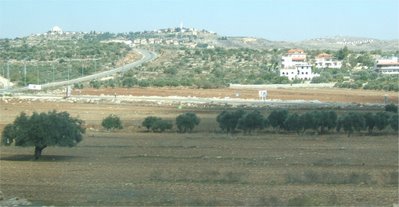

Route 60 Shown above in Yellow
But first, it’s necessary to pass through Israel’s new four-lane pseudo-border crossing, the Hizma checkpoint. The thick concrete walls and endless spirals of razor wire instill a deep sense of unease, like walking into a leopard’s cage. The physically intimidating fortifications imply the need for protection from an equally massive destructive force.
Winding down route 66, small Arab villages fly by my window, chaotic and organic, settled in the valleys. Anchored to the hilltops are tight, regimented rows of identical red-roofed homes, the Jewish communities of Samaria, rebuilt on land captured after Israel repelled the 1967 Jordanian invasion.

Looking back over the fence at Pisgat Ze'ev
From the perspective of one who lives on the Israel side of the fence, it seems to be made to instill a sense of comfort and protection. But as Malkah, who lives on the opposite side of the fence, told me, “It’s trying to send a message to us on the other side that our lives are for nothing. That we should stop wasting our effort building our Jewish communities because they are on the other side of the fence and will eventually be destroyed anyway.”

New trailers outside the Jewish town of Beit El
My own feeling is that the fence is an expression of the Israeli ethos of the “New Jew,” the spiritual person melted down and recast in the image of a secular nationalist. The Arabs, in their persistent and apparently irrational refusal to recognize the legitimacy of Jewish independence, long after they have shook hands and broken bread with virtually all other nations in the world, are an eternal reminder that despite Zionism’s best efforts they still see and hate us as Jews, not Israelis. Likewise, these settlers living here, with their head coverings and unashamedly Jewish ideology, are a shameful reminder of the failure of Zionism to re-make the people. The fence sends a message to it’s makers, “No, don’t look behind that concrete curtain over there. We have glass skyscrapers in Tel Aviv, our academics win Nobel Prizes, we have Olympic gold medalists. That’s us. Over there is not us.”
 The fence, and the Jewish town of Adom in the background
The fence, and the Jewish town of Adom in the background
After a few minutes cruising between the hilltops, the eyes grow accustomed to the sights, and the fact that we are no longer separated from the Arab population is less and less alarming. Mountains are punctuated by flat valleys, lined with olive orchards. Vineyards are squeezed into the terraced steps running up the hillsides.
Side-routes to Jewish and Arab villages feed off the highway. Along some portions, the road is lined with barbed wire and concrete watchtowers.

Concrete towers on the road
At others, there is seemingly little security. At one point, the road passes straight through the Arab village of Huwwara. Felafel stands, auto mechanics, and grocery stores all display prominent signs in both Arabic and Hebrew. Reminders of better days, when Jews came out here to do business, go shopping, or just take a day off in these places. Despite the seemingly benign appearance, not too different from the offramps and rest stations along California’s route 5, one dare not stop.
The deterioration of the security situation along this road over the last two decades bespeaks a deeper problem. When a people surrenders the moral high ground, it can be just as lethal as an army surrendering the physical high ground. The only reason all of these fortifications are necessary is because the Israeli government imported, armed, and empowered some of the country’s worst enemies. And the only reason they did that was because they relinquished their own unique claims to the land in the 1990’s. It was this surrender of the moral high ground that lead to the surrender of the physical high ground.
As the road passes around Nablus, it gradually twists and winds its way up the hill, to the town of Elon Moreh, one place which has surrendered neither the moral nor the physical high ground.

On the road to Elon Moreh
Coming around a bend in the road, we are confronted by a sign welcoming visitors. This is Shabbat Lech Lecha, the portion of the yearly Torah cycle where we read about the biblical Abraham first arriving in the land of Israel, first visit.
And Avram passed through the land
until the place of Shechem,
until ELON MOREH,
and the Cananite was then in the land.
And HASHEM was revealed to Avram, and said:
to your descendants I will give this land,
and he built an altar there
to HASHEM who was revealed to him.
Breshit (Genesis) 12: 6-7
This being the first mention of Elon Moreh in the bible, the yearly reading of this portion has become a day of pilgrimage to the rebuilt city.
A sign "Here it comes, Shabat Parashat (portion) Lech Lecha"
Stay tuned for pictures from Elon Moreh!

1 comment:
It's fun to write about. Good idea about the hyperlinking. Takes TIME though. Lots of precious TIME.
Post a Comment